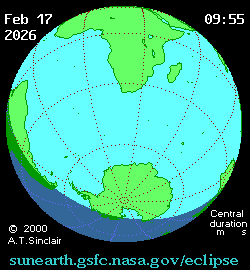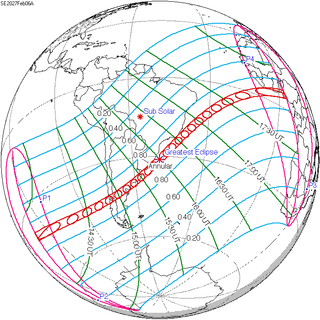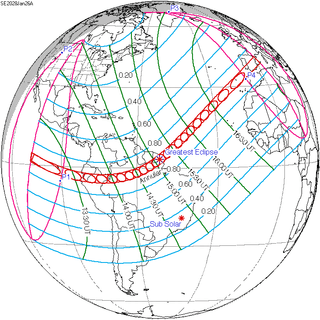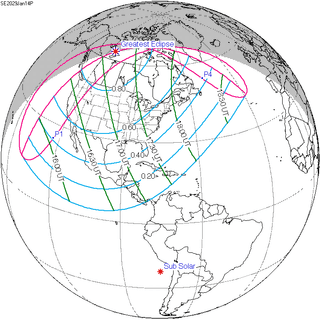Solar eclipse of February 17, 2026
| Solar eclipse of February 17, 2026 | |
|---|---|
 Map | |
| Type of eclipse | |
| Nature | Annular |
| Gamma | -0.9743 |
| Magnitude | 0.963 |
| Maximum eclipse | |
| Duration | 140 sec (2 m 20 s) |
| Coordinates | 64°42′S 86°48′E / 64.7°S 86.8°E |
| Max. width of band | 616 km (383 mi) |
| Times (UTC) | |
| Greatest eclipse | 12:13:06 |
| References | |
| Saros | 121 (61 of 71) |
| Catalog # (SE5000) | 9565 |
An annular solar eclipse will occur on February 17, 2026. A solar eclipse occurs when the Moon passes between Earth and the Sun, thereby totally or partly obscuring the image of the Sun for a viewer on Earth. An annular solar eclipse occurs when the Moon's apparent diameter is smaller than the Sun's, blocking most of the Sun's light and causing the Sun to look like an annulus (ring). An annular eclipse appears as a partial eclipse over a region of the Earth thousands of kilometres wide.
Images

Animated path
Related eclipses
Solar eclipses 2026-2029
Each member in a semester series of solar eclipses repeats approximately every 177 days and 4 hours (a semester) at alternating nodes of the Moon's orbit.
| Ascending node | Descending node | |||||
|---|---|---|---|---|---|---|
| 121 | February 17, 2026 Annular |
126 | August 12, 2026 Total | |||
| 131 | February 6, 2027 Annular |
136 | August 2, 2027 Total | |||
| 141 | January 26, 2028 Annular |
146 | July 22, 2028 Total | |||
| 151 | January 14, 2029 Partial |
156 | July 11, 2029 Partial | |||
| Partial solar eclipses on June 12, 2029, and December 5, 2029, occur in the next lunar year eclipse set. | ||||||
References
| Wikimedia Commons has media related to Solar eclipse of February 17, 2026. |

